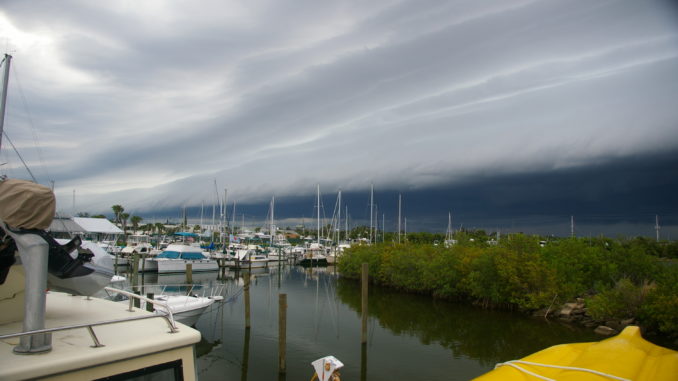
MarinaLife Magazine invites you to learn more about boating in their online offering called Ask the Captain. Here is one of our latest articles about preparing for a storm…anytime of the year!
Ask the Captain Courtesy of MarinaLife.com
If you don’t know what MarinaLife is, just check it out!
Hurricane Preparedness
Written by Captain Chris Caldwell
To prepare your boat for safely riding out a storm in your marina here are a few tips. Be sure to minimize the vessel’s wind resistance by removing everything that can be detached from your vessel: the canvas, vinyl windows, sails, sail covers and don’t forget the dinghy.
Next, think. Think about the wind direction, tidal rise and possible current then secure the boat with dock lines to keep the boat off the downwind or down current finger pier. Since tidal rise is often a concern be sure to tie your dock lines high enough so that when the water rises the dock lines are at the proper upward angle. If there is too much downward tension then strain is created against the dock line and cleat.
Many people use the spider web approach to tying a boat in the slip. You do not want the wind to force your swim platform or anchor pulpit against the dock. To avoid this, move your boat out into the fairway a little bit. All the additional spring lines that will keep your boat in the center of the slip give a spider web appearance. Ask your boat neighbors or marina management for their thoughts. Maybe some have already been through a hurricane in your marina and can offer their experiences- good or bad.
Secure your fenders. More is better. Place them at the widest point of the boat, usually the mid-section and then consider the storm influence and place more fenders where the vessel impact may be the worst. A larger diameter fender or ball placed at the stern and curved bow helps with gusting winds. If there are some empty slips in your marina get permission to move to a larger slip. This may give your boat more elbow space to move around during a strong wind.
Docklines should be inspected before you depend on them. If you need more docklines consider buying a spool of rope and making your own storm lines. Usually there are 600 feet per spool so you may want to find a marina neighbor to go in on half the cost for 300 feet of your spool. If you do not know how to splice just use a BBQ propane lighter to melt the ends of nylon rope and tie bowlines for the pilings and a cleat knot to secure to the dock. Don’t know how to tie a proper bowline knot? Maybe a marina neighbor can help you right now but this is a skill all boaters should practice and master.
Examine the condition of the dock and cleats. Are they sturdy enough to hold your boat in a storm? Look to see how the cleats are screwed or bolted into the dock. Sometimes we see cleats through-bolted and back-plated into the dock plank. Then the plank is screwed into the dock beam with self-tapping screws. That means the boat is tied to a plank with wood screws as the main fastener. That may not be enough to hold your boat securely in high winds.
Now look at the pilings which are your strong point. Learn how to tie a clove hitch high on the piling. Whether wooden or concrete pilings, this is a hurricane so do the best you can.
Prepare your boat to do without shore power. Either the marina will be proactive and turn off the power or the entire area may lose power. Make sure your batteries are charged and the perishables are removed from the refrigerator. The YUK factor when food is left aboard needs no explanation.
We’ll talk about hurricane haul-outs in a separate posting. In the meantime, take photos of the boat and the steps you have taken to secure her for the hurricane and then GO HOME, take care of your house and be safe.
Captains Chris & Alyse Caldwell are USCG 100 ton Masters and Cruising Coaches who offer Personal Boat Training Online or Onboard your boat anywhere! The Caldwell’s help build your cruising confidence with hands-on training and with their AskCaptainChris.com training videos filled with tons of tips for the boater who loves learning. If you have additional questions for Captains Chris or Alyse, please email them at chris@captainchrisyachtservices.com
